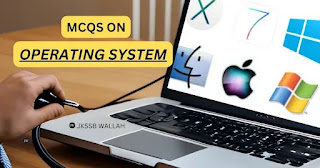MCQS ON OPERATING SYSTEM
1. What is NOT a main function of an operating system?
a) Memory management
b) Task scheduling
c) Internet browsing
d) File management
The correct answer is c) Internet browsing.
2. What is the primary purpose of an operating system?
a) Running applications
b) Managing hardware resources
c) Providing internet connectivity
d) Creating documents
The correct answer is b) Managing hardware resources.
3. Which memory management technique is used to overcome issues of memory fragmentation?
a) Paging
b) Segmentation
c) Virtual memory
d) Swapping
The correct answer is a) Paging.
4. The CPU scheduling algorithm which gives each process a fixed time in cyclic order is called:
a) Round Robin
b) First-Come, First-Serve
c) Shortest Job Next
d) Priority Scheduling
The correct answer is a) Round Robin.
5. In an operating system, what is the purpose of the ‘fork’ system call?
a) To allocate memory
b) To create a new process
c) To delete a process
d) To terminate the CPU execution
The correct answer is b) To create a new process.
6. Which type of file system maintains a hierarchy of directories, subdirectories, and files?
a) FAT
b) NTFS
c) Ext4
d) Hierarchical File System (HFS)
The correct answer is d) Hierarchical File System (HFS).
7. What is the role of the ‘bootloader’ in an operating system?
a) Manages peripherals
b) Executes application software
c) Boots up the operating system
d) Schedules processes
The correct answer is c) Boots up the operating system.
8. Which process scheduling algorithm may lead to starvation?
a) Shortest Job Next
b) Priority Scheduling
c) Round Robin
d) First-Come, First-Serve
The correct answer is b) Priority Scheduling.
9. Which term refers to a condition when two or more processes are each waiting for another to release a resource?
a) Deadlock
b) Starvation
c) Race condition
d) Thrashing
The correct answer is a) Deadlock.
10. What is a process in an operating system?
a) A thread of execution
b) A program in execution
c) A file system
d) A network connection
The correct answer is b) A program in execution.
11. What is the purpose of a ‘mutex’ in concurrent programming?
a) To synchronize file access
b) To synchronize memory access
c) To allocate CPU time
d) To handle exceptions
The correct answer is b) To synchronize memory access.
12. Which of the following is NOT a type of operating system?
a) Real-time OS
b) Batch OS
c) Graphical OS
d) Embedded OS
The correct answer is c) Graphical OS.
13. What is the purpose of an interrupt in an operating system?
a) To execute an application
b) To start a new process
c) To request CPU time for a process
d) To transfer control to a different part of the program
The correct answer is d) To transfer control to a different part of the program.
14. Which scheduling algorithm selects the process with the smallest execution time next?
a) Round Robin
b) First-Come, First-Serve
c) Shortest Job Next
d) Priority Scheduling
The correct answer is c) Shortest Job Next.
15. What does the abbreviation ‘I/O’ stand for in operating systems?
a) Input/Output
b) Inclusion/Operation
c) Interrupt/Output
d) Integration/Observation
The correct answer is a) Input/Output.
16. What is the purpose of a ‘shell’ in an operating system?
a) To manage hardware resources
b) To manage system memory
c) To provide a user interface
d) To schedule processes
The correct answer is c) To provide a user interface.
17. What is the purpose of ‘swapping’ in an operating system?
a) To move processes from main memory to disk
b) To schedule processes for execution
c) To allocate memory to new processes
d) To synchronize processes
The correct answer is a) To move processes from main memory to disk.
18. Which memory management technique uses both main memory and disk space to store processes?
a) Paging
b) Swapping
c) Segmentation
d) Virtual memory
The correct answer is d) Virtual memory.
19. What is the purpose of a ‘scheduler’ in an operating system?
a) To allocate memory
b) To manage hardware resources
c) To handle exceptions
d) To decide which process runs next
The correct answer is d) To decide which process runs next.
20. What is the main purpose of the ‘kernel’ in an operating system?
a) To provide a user interface
b) To manage hardware resources
c) To execute application software
d) To manage disk space
The correct answer is b) To manage hardware resources.
21. What is the purpose of the ‘pipe’ in Unix-like operating systems?
a) To redirect input/output of processes
b) To create a new process
c) To allocate memory
d) To manage disk space
The correct answer is a) To redirect input/output of processes.
22. Which type of operating system manages resources for a single user?
a) Multi-user OS
b) Single-user OS
c) Real-time OS
d) Multi-tasking OS
The correct answer is b) Single-user OS.
23. Which component of an operating system is responsible for managing memory and storage resources?
a) Kernel
b) File System
c) Scheduler
d) Monitor
The correct answer is a) Kernel.
24. What is the role of the ‘command interpreter’ in an operating system?
a) Allocating memory
b) Managing hardware resources
c) Providing a user interface
d) Scheduling processes
The correct answer is c) Providing a user interface.
25. Which file system is commonly used in Linux operating systems?
a) FAT32
b) NTFS
c) HFS+
d) Ext4
The correct answer is d) Ext4.
26. What is the purpose of the ‘page table’ in virtual memory management?
a) To store program instructions
b) To allocate main memory
c) To map virtual addresses to physical addresses
d) To manage CPU registers
The correct answer is c) To map virtual addresses to physical addresses.
27. Which type of operating system is designed to respond to events within a certain time period?
a) Real-time OS
b) Batch OS
c) Multi-user OS
d) Distributed OS
The correct answer is a) Real-time OS.
28. Which mechanism in an operating system ensures that no two processes can access shared resources simultaneously?
a) Lock
b) Interrupt
c) Buffer
d) Semaphore
The correct answer is a) Lock.
29. What is the purpose of the ‘bootloader’ in an operating system?
a) To manage memory resources
b) To load the operating system into memory
c) To manage disk space
d) To execute application programs
The correct answer is b) To load the operating system into memory.
30. What is the role of the ‘file system’ in an operating system?
a) To allocate CPU time
b) To provide a user interface
c) To manage hardware resources
d) To manage files and directories
The correct answer is d) To manage files and directories.

